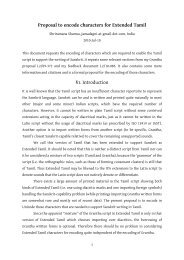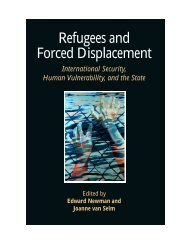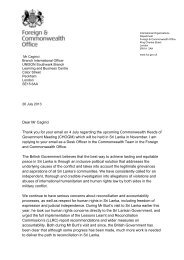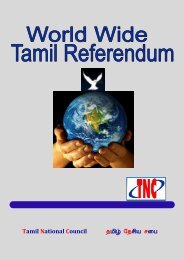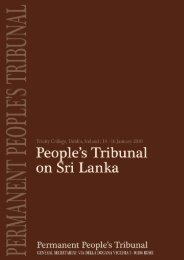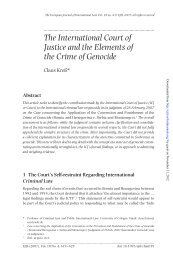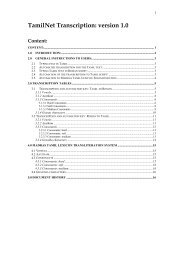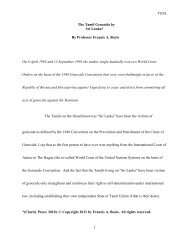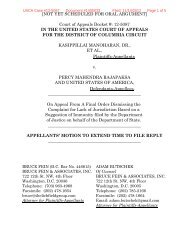Untitled - International Commission of Jurists
Untitled - International Commission of Jurists
Untitled - International Commission of Jurists
You also want an ePaper? Increase the reach of your titles
YUMPU automatically turns print PDFs into web optimized ePapers that Google loves.
majority pro-Sinhala political leadership. A prominent activist has since commented<br />
on the failure <strong>of</strong> senior Tamil politicians at that time to recognise the danger signs.<br />
“Those with nationalist sympathies had little difficulty in swallowing this<br />
propaganda [against Alfred Duriappah] and failed to ask where this was<br />
leading to. Planted in the minds <strong>of</strong> youth who were on the threshold <strong>of</strong><br />
militancy, it was an instigation to kill.” 29<br />
The senior Tamil leaders were accused by the government <strong>of</strong> practicing non-violence<br />
only in theory whilst encouraging violence against the State. Mainstream Tamil<br />
parties joined together to form the Tamil United Liberation Front (TULF). At its first<br />
National Convention, held at Vaddukoddai on 14 May, 1976 and presided over by<br />
S.J.V. Chelvanayakam, the TULF unanimously adopted a resolution calling for the<br />
formation <strong>of</strong> a separate state <strong>of</strong> Tamil Eelam.<br />
The politics <strong>of</strong> violence saw an upsurge after 1977 when the UNP, headed by J.R.<br />
Jayawardene, came into parliament on a two-thirds majority. With the electoral<br />
decimation <strong>of</strong> the SLFP, the TULF became the major opposition party after securing<br />
the North on a secessionist electoral campaign. Communal violence followed the<br />
elections. Tamils were killed in riots across the island, and large numbers were<br />
displaced. The killing <strong>of</strong> a police <strong>of</strong>ficer, Inspector Bastianpillai, led to the<br />
proscription <strong>of</strong> the militant movement later to become the Liberation Tigers <strong>of</strong> Tamil<br />
Eelam (LTTE).<br />
Using the COI Act <strong>of</strong> 1948, the Jayawardene government appointed a <strong>Commission</strong> <strong>of</strong><br />
Inquiry into the incidents that took place between 13 August and 15 September, 1977,<br />
popularly referred to as the Sansoni <strong>Commission</strong>. The Second Republican<br />
Constitution (‘the 1978 Constitution’) came into effect on 31 August, 1978. It<br />
established the Executive Presidency and replaced the first-past-the-post electoral<br />
system with proportional representation. The 1978 Constitution recognised both<br />
Sinhala and Tamil as national languages while continuing to state that Sinhala will be<br />
the <strong>of</strong>ficial language. 30 Tamil was eventually given <strong>of</strong>ficial language status thorough<br />
constitutional amendments in the 1980s. 31 The Tamil community’s grievances might<br />
have been mitigated had these constitutional provisions been incorporated at the<br />
outset. That said, these provisions have been only weakly implemented to date. 32<br />
29 Hoole, Rajan, op. cit, at p. 18. At p. 8, it is observed that “It is difficult not to be moved by<br />
Chelvanayakam. But on looking back, it is also difficult to avoid the conclusion that the isolation and<br />
exclusive sense <strong>of</strong> victimhood (that) Federal Party politics brought to the Tamils was unhealthy and<br />
ultimately tragic. There was little recognition by him that the Left which was then powerful in the<br />
South, took the same stand as the Federal Party on the key issues <strong>of</strong> the day- the citizenship and<br />
language issues. The possibility <strong>of</strong> an alliance was never taken seriously, if ever contemplated.”<br />
30 Articles 18 and 19 <strong>of</strong> the 1978 Constitution in its unamended form.<br />
31 2 nd , 4 th , 13 th and 16 th Amendments.<br />
32 Shanthakumar, B. (ed.), ‘Language Rights in Sri Lanka – Enforcing Tamil as an Official Language,’<br />
Law & Society Trust, 2008. The language issue is key in drawing lines between the Sinhala and Tamil<br />
people. A recent study done by the Official Languages <strong>Commission</strong> covering a population <strong>of</strong> over 3.5<br />
million <strong>of</strong> which over 1.1 million were Tamil speaking people living outside the Northern and Eastern<br />
provinces found that, <strong>of</strong> the 6,626 public <strong>of</strong>ficials <strong>of</strong> all grades working there, only 627 or 9.5 per cent<br />
were pr<strong>of</strong>icient in Tamil. A similar study was conducted in the Northern and Eastern provinces found<br />
that (in respect <strong>of</strong> the over 1.5 million population in these provinces <strong>of</strong> which the Sinhala speaking<br />
population was a little over 365,000), only 98 or 18.1 per cent <strong>of</strong> the total <strong>of</strong> 540 public <strong>of</strong>ficials<br />
serving, were pr<strong>of</strong>icient in Sinhala - vide interview with Mr Raja Collure, ‘Official Languages Policy -<br />
23



